
Teppy
-
Posts
48 -
Joined
-
Last visited
Content Type
Profiles
Forums
Store
Help Articles
Posts posted by Teppy
-
-
I am experimenting with making emulsions in a Q700 sonic homogenizer. I've tried making various nut milks/creams, but in each case I'm getting a rancid smell. Some online research indicates that this is a common problem - it's essentially burning the oil at a microscopic level even though the mixture is mostly water. Turning down the amplitude to 10% reduces this but doesn't eliminate it, and turning it down much further causes it not to emulsify. I was just at Noma where they served a nonalcoholic cocktail made in a sonic homogenizer which had a completely clean flavor, so I know that it's possible to use this device in a kitchen. Any ideas?
-
 1
1
-
 1
1
-
-
Well, I did it as above. I definitely get a nice truffle flavor, but even at 20% truffles it's not super intense. I wonder if I'm so used to chemical truffle oil that the real thing just isn't so impressive.
-
I've noticed that (winter) black truffles have a much stronger taste when cooked. To maximize their flavor, I'm planning to make truffle butter like this:
4 parts clarified butter by weight
1 part black truffles by weight
Chop truffles in a food processor. Combine truffles and butter, vacuum seal, sous vide at 80C for one hour, freeze.
So my questions for those that have experimented with truffles:
Am I using too high a ratio of truffles to butter? (Does the flavor tend to saturate so that I'm wasting truffles?)
Is 80C warm enough? Too warm?
Is an hour enough time to extract the flavor? Too much time?
Will the brief exposure to vacuum evaporate lots of the volatile truffle flavors?
Does freezing the result degrade the flavor in any way?
It's very hard to find this sort of info online or in any cookbook that I've come across.
-
I'm helping to start a restaurant in Pittsburgh, and one code requirement is baffling me: The makeup air for the hood is required to be heated.
I understand the reason for makeup air itself, but why heat air that will be ejected through the roof a second later? This adds $4000 or so to the cost of the hood, and $13-$52 per hour that the unit operates (1M-4M BTU/hr, which is just a guess - we need to have an approved engineer tell us the size of the makeup air heater we need.)
I've asked this question of two different companies that sell the makeup air heaters, of several local chefs, and of several hood installers, and everyone's answer is the same: "I don't know, but the code requires it, so there's no use arguing about it." I even read the code itself, and it's true that heated makeup air is required, but there's no explanation of why.
Guesses have included "for the comfort of the chefs" (Pittsburgh is cold in the winter), that cold air tends to fall (the makeup air should go up the hood), that the temperature differential could cause grease to condense faster and create a fire hazard by sticking to the ductwork, and that some cold makeup air might escape into the dining room.
Perhaps I'll invent a sink whistle and lobby to have that written into the code.
-
 1
1
-
-
I own a number of shave ice machines, and have evaluated many others. (I'm not in the business, I just love shave ice.)
The gold standard for snow quality are those machines, either powered or hand-cranked, that turn a solid piece of ice over a blade. It's a minor pain to freeze the ice, you must keep the blade sharp, and they're slow compared to cube-based machines. Swan and Hatsuyuki both make quality machines for around $2000.
The most basic kind of cube machine is made by Gold Medal ("Sno King", though they have a bunch of equivalent models), and is found at most carnivals. They run about $700, and make poor quality, chunky ice. They have two blades which spin against a chamber of ice cubes. They're extremely fast, and are a great way to turn out ice for presentation.
Hand ice shavers are cheap ($30) and make ice identical to Gold Medal shavers. You can find them on ebay.
Hatsuyuki, Gold Medal, and Swan all make a new design of shaver that turns a spiral shaped chamber of cubes over a single blade. This produces ice that is significantly better than Sno Kone machines, but far from solid ice machines. They're slow and cost about $1500.
One company - "Snowie" - makes a unique design that turns a chamber of ice cubes across a circular band with many sharp slits. The quality isn't quite that of a properly maintained solid block machine, but it's close, and it holds the syrup well. The machines are really fast - the high-end model (Snowie 3000) can chew through a 7 pound bag of ice cubes in about a minute. It runs about $2500. I'm wild about this machine.
They make a model for home use called "Little Snowie" that uses the same technology, but in a smaller format. I haven't used one. They run about $300, and I've heard the ice quality isn't quite that of the Snowie 3000, but I'd expect it to be far better than the spiral chamber machines.
For the last few years I've given away alcoholic shave ice at Burning Man ("Shaven, Not Stirred".)
-
I'm planning to give away about 1000 alcoholic shave ice/snow cones at Burning Man, two weeks from now. I won't have access to fresh produce, but I'm using high quality powdered flavors (TropicalSno). I'll be doing classic drinks including margaritas, daiquiris, etc.
I'd imagine that cheap vodka (Potter's, at $10/1.75L) won't make a difference in taste.
What about rum - will the difference between very cheap rum (Potter's $12/1.75L) and something in the $20 range be noticeable?
And finally, Tequila - $17 for good old Potter's, $25 for Cuervo Gold, or $?? for something better?
BTW - any eGullet folk going to Burning Man? I'll be in the 9:00 Plaza, camped with Enlightenedville.
-
Here's a cocktail that I made recently, the "Meat Lover's Martini":
Rim a martini glass with powdered beef bullion, fill with cold bacon vodka and garnish with a strip of buffalo jerky.
Most people at the party hated it, but a few loved it.
-
I'll second Rabbit (definitely) and Goat (I hope!). I've seen rabbit pop up in a number of fine-dining spots in Pittsburgh, all at once. Of course, this would be the first time we've led any food trend.
I'm seeing goat in ethnic markets - maybe it's always been there, but they really seem to be advertising it now. I've also seen it on the menu at two Indian restaurants, where previously it was a rare special. Tandoori goat chops are amazing.
-
For savory ice creams, I use maltodextrin, which is available at brewing supply stores. It's barely sweet eaten straight, and not sweet at all if you use some salt in your mixture. The final texture will be 100% identical to ice cream. I haven't tried a sorbet yet with it, but I see no reason for that not to work.
-
For doing the whole canister that would work, but portion-by-portion, not so well.
One idea I had was to make hollow cylinders of cocoa butter and fill those with whatever flavoring ingredient I'm using - potato chips, cake, etc. Stand those up on-end in the liquid base and then freeze the whole thing.
-
Just got one, it's awesome, but I've noticed a problem that may tend to come up a lot: How do you deal with mixes containing ingredients that float or sink? For instance, I tried to do a potato chip ice cream, and the chips floated in the milk base, so the top of the beaker had far too high a concentration of chips.
A similar problem occurred with "birthday cake" ice cream - the cake chunks sank, so that the first servings had very little cake taste, and the bottom had way too much cake (and sugar.)
Any tricks for situations like these?
Any other cool Pacojet tricks?
-
-
So finally the stores around here are stocking goose. I've been cooking goose for years - certainly my favorite bird. Duck is a distant second.
It seems that each time I cook a goose I discover another part that is particularly tasty. The legs are tender and full of flavor. The wings, if not overcooked, are rich with sticky gelatin. And the neck with it's super-dark meat and chewy texture is fantastic. The giblets, pureed with fat, spread on bread and toasted, make a wonderful start to the meal. The fat itself makes any vegetable into a main dish.
Of course the skin - separated and slowly cooked in it's own fat - is the food equivalent of heroin. Chewy, rich, crispy salty goodness. Just tonight I took all the tough muscles and connective tissue from the back (which can be sort of slimy) and I slowly re-cooked them in the fat rendered from the skin, and sprinkled a bit of truffle salt . What was previously "junk" meat was suddenly the best. Almost a goose confit.
Which brings me to my question. What the hell do I do with the breast meat? That's supposed to be the best, right? But compared to everything else it's dry and bland. If only there was a use for the breast meat, I could pronounce goose, "Nature's Most Perfect Food."
-
I wonder if you could do the tempura porridge balls so that they're actually liquid inside. Make balls in one of those spherical ice cube trays and freeze them. Then make a porridge with eggs and flour, dip the frozen balls in that, deep fry to seal in the liquid, and then possibly deep fry again once the inside has melted.
-
Ok, I just checked some food prices here in Pittsburgh, and fortunately things seem to be under control. Foie gras is still available at $39/lb as it has been for several years. Whole goose is plentiful at about $50 for a large goose, and dry aged beef is in good supply at around $20/pound for NY strips.
-
I've been pondering a similar thing about wines. I've been fortunate enough to try several "legendary" wines over the years that I can recall the flavors of. Could we take a neutral tasting wine (cheap Bordeaux for instance), centrifuge it to encourage tannins to clump together, and then doctor it up with tiny amounts of volatile compounds to simulate specific rare wines? Perhaps simulating rare wines is a skill that an individual could develop.
-
A few friends went to WD-50 and we all had 9-course tasting menus, including one vegan - she proclaimed it "the best meal I have ever eaten."
I think that the best chefs tend not to limit themselves to vegan cooking, but when called upon can turn out amazing vegan food.
-
Anyone know how this would taste like?
I've had raw whale, and that had a sort of liver taste, and a texture like very firm fish (firm like ahi tuna, but more so.) On the exotic foods deliciousness scale, where Durian is a 10 (Yum!) and Natto is a 1, raw whale was about a 4.
-
Hope I did all these calculations right.
Assume you want to raise the temperature in 1 pound of potatoes from 62F to 212F: That takes 200 BTUs. Then, you want to vaporize 0.5 pounds of water from the potatoes: That takes 485 BTUs. So, how long to get 685 BTUs from a 110V, 15 Amp electrical outlet? That's 1650W, so over one hour you can draw 1650*3.412=5629 BTUs. (So the best you can do with a home deep fryer using a 15 Amp circuit is 5629 BTU/hr. Typical gas burners on a home range are about 10,000 BTU/hr. Comercial gas-fired deep fryers are up to 160,000 BTU/hr.)
So with perfect efficiency, the potatoes cook in 685/5629 hours, or about 7.3 minutes. Probably fine for cooking a pound of potatoes, but probably not good for cooking 2+ pounds at once.
-
You mention sous-vide by just adding a circulator. Actually, immersion circulators seem to work differently from things with a normal thermostat. As they get close to the desired temperature, they pulse the heating element on and off, and sort of learn what ratio of on/off is needed to maintain temperature in the pot you're using.
Is anyone doing a low-cost (say, $200-$300) immersion circulator yet? I'm sure sous-vide setups will be as common as microwaves in 10 years. It just makes perfect meat cooking embarrasingly easy.
-
I haven't quite gotten it right, but I think that balsamic snow kones are promising. Straight with lots of sugar was both too sweet and too sour, but maybe a simple syrup flavored with balsamic over finely saved snow, served as an intermezzo would be good.
-
If I did the calculations right, the pilot lights eat about $60 of natural gas bill each month, though in the winter it's a wash, since the furnace would tend to run less. If I turn on everything full-blast, the whole setup eats $6.30/hr in gas.
Most people I talked to said the ansul system would be a waste - it only triggers if the hood temperature exceeds 1200F, which means a pretty massive grease fire. I did buy a "B-C" type fire extinguisher to keep nearby.
-
Everyone from local restaurant supply places and chefs, to the equipment manufacturer told me that installing pro equipment in a home is a big mistake. I know a lot of people here have considered this, so I thought I'd share my recent experience.
First off, the fine piece of equipment that I've been cooking on for the last 6 months. BTU output is approximately that of a Bic lighter:
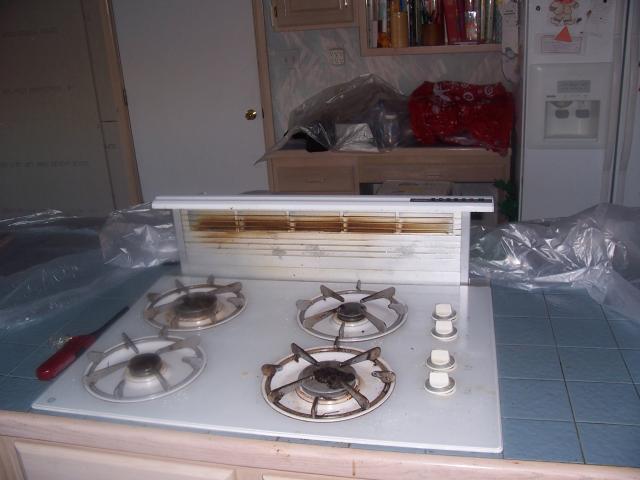
Primarily, I wanted a stove with much higher output. I had 9 feet to work with, so I figured I'd use the whole space and get some additional toys to fill it up.
For the project, I first called the local building inspector and discussed my plan - he said that in our township, no special inspections or permits were required, as long as things were installed according to manufacturer's specifications. I also later contacted my insurance company to make sure nothing special was needed from them - they said commercial equipment in a home is fine. (Nationwide)
I decided on a 60" stove with 2' of griddle and 6 burners, a standard sized deep fryer, and a "jet" wok burner. In total, 552,000 BTU/hr. The "before" picture:

First, the pantry was removed, and pipes+electrical relocated. Existing drywall was removed and replaced with a double layer of 1/2" fireproof cementboard. Also, a 9' x 4' sloped hood was installed.
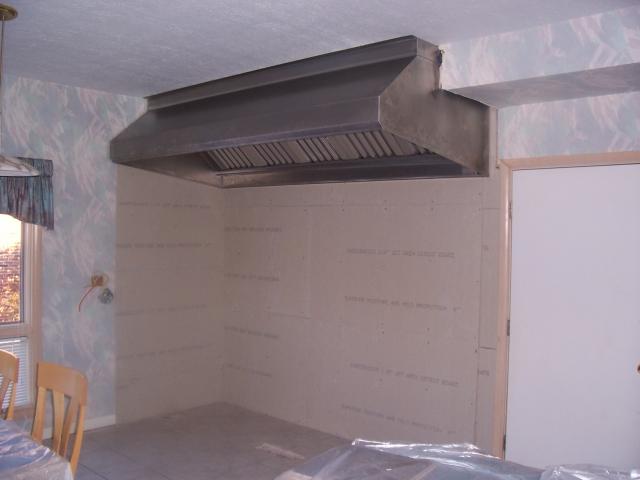
The hood was sized so that it extended by at least 6 inches on all sides. It vents out the back wall. Next, this exhaust fan:
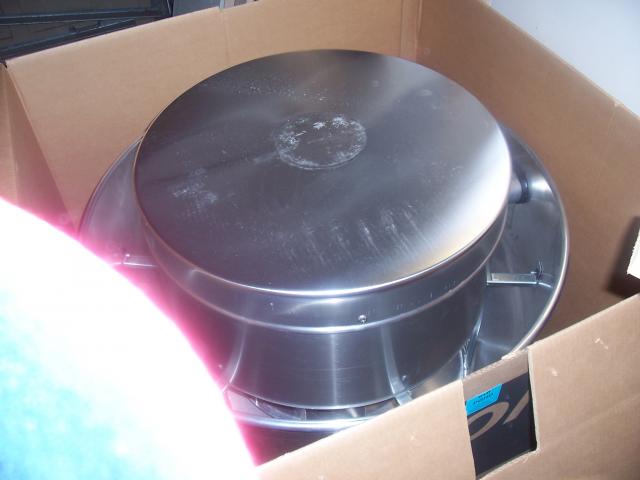
was installed on the roof:
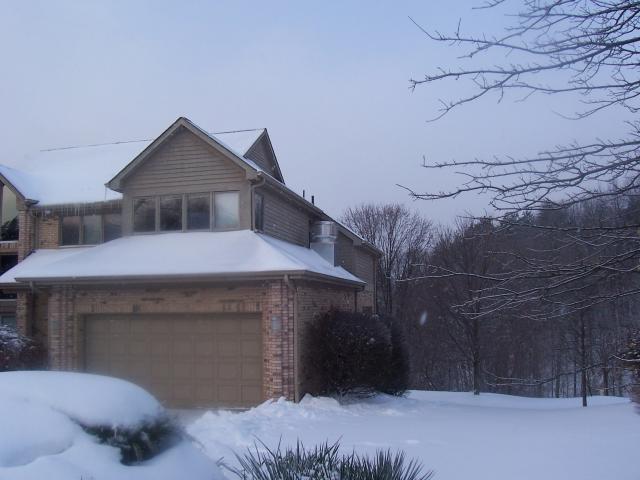
Removing the pantry left holes in the tile floor, so we cut out the old section of floor, put down 1/4" plywood and new tiles. Also, installed stainless steel over all exposed cementboard:
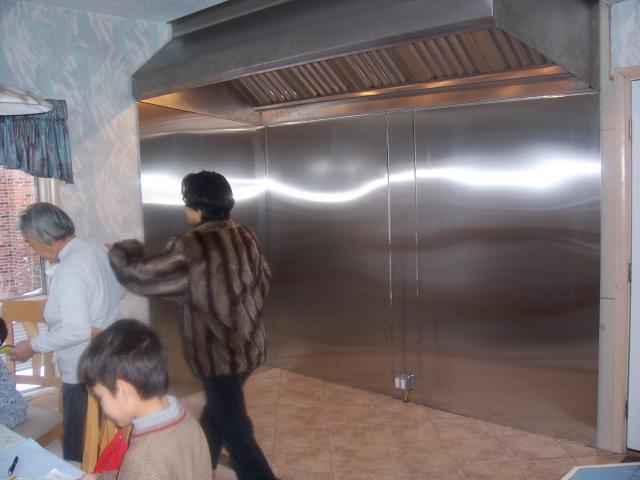
We ran a 1.25" gas line from the main house line, then split that into 3 3/4" connections. Finally, the equipment was moved in and hooked up:
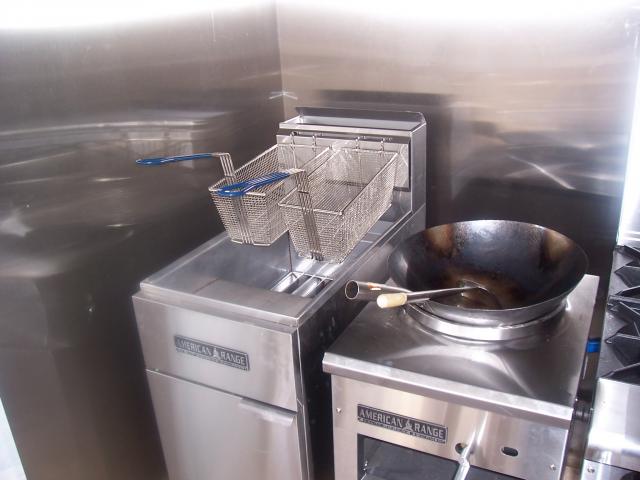
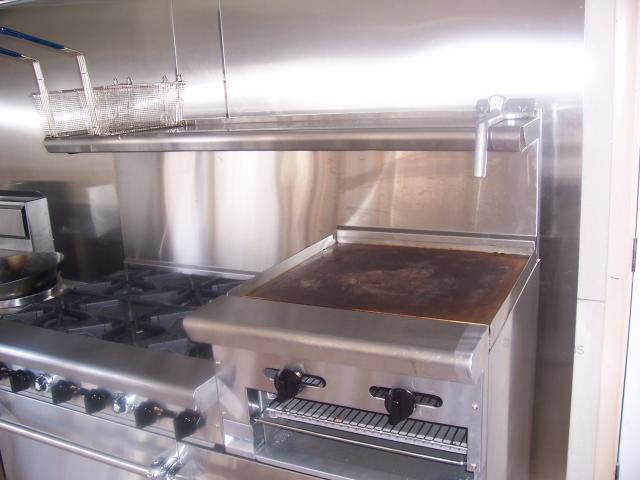
Approximate project costs: Range $4200, Wok burner $800, Deep Fryer $800, Hood $1700, Ductwork $1300, Electrical $300, Gas Lines $1050, Exhaust Fan + Grease Trap $1400, Floor $500, Carpenter $1500, Materials $500. Total around $14,000.
I've had this in place for about 3 days now. So the big question - am I glad I did it? Absolutely! I can't begin to explain what a pleasure this is to cook with, compared to what I was using. For instance, I like to make fried cabbage (in goose fat!) - typically I'd get all 4 burners going with various sized pans on that old stove, or do the cabbage in small batches on one or two burners. (Otherwise it sort of steams before it carmelizes.) Last night I shredded an entire cabbage, spread the whole pile over the griddle, and had perfectly done fried cabbage in 10(?) minutes.
The burners are 32,000 BTU/hr each - where I would previously use multiple (10k and 7k) burners and cook in small batches, now I can use a single large pan.
I find that I'm using the wok burner more than anything else. Vegetables cook in minutes. I'll put some oil and turn on the burner full-blast; in maybe 10 secconds the oil is close to smoking. I'll add the vegetables and salt, and cook for 20-60 seconds - this carmelizes the outsides, but the insides are still raw. (It's possible to end up with veggies that are at once both burned and raw.) Then I'll add a bit of water, which effectively lowers the temperature to 212, and cook until they are soft. Then, a quick final blast to evaporate any remaining water. Meat - even when cut fairly small - gets brown and delicious on the outside, and stays pink on the inside.
I haven't fired up the deep fryer yet. It was a huge pain to clean initially, and I'd imagine even moreso when dealing with hot oil. So, I'll reserve judgement on that item.
But so far, I'm thrilled with the new setup.
-
An update on my vent hood project: The interior work is now done except for the wood trim:

And the exhaust fan is installed:

All that's left to do is to weld the ductwork between the hood and fan, and run the gas lines. The equipment arrives next week - I'll post final pictures then!

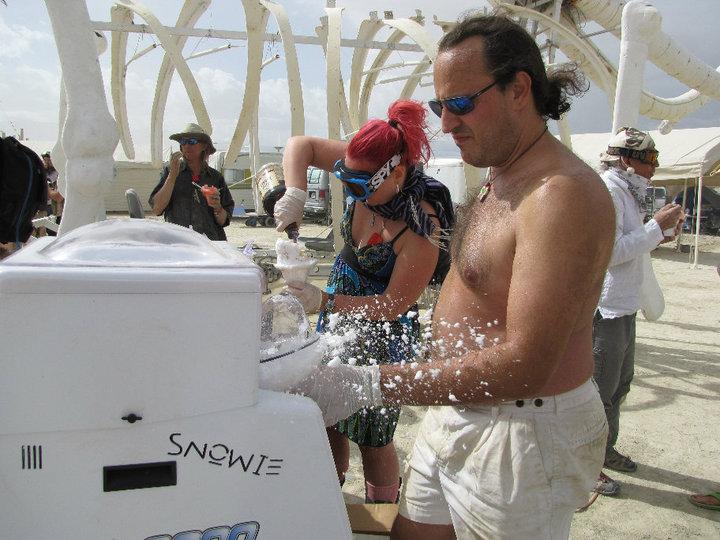
Ultrasonic Homogenizers (Sonicprep)
in Kitchen Consumer
Posted
The liquid stays fairly cool unless I run it for many minutes at a high power setting. I've even tried placing ice cubes in the liquid, but that doesn't help.